Embroidery Trends
In today’s increasingly detached era of instant satisfaction, where everything is just a phone tap away, the little details of embroidery give a certain calm to the garments. The art of displaying adornments on the fabric or any other product with the help of needle and thread is Embroidery. Such details add an element of storytelling to the monotonous garment. This thread craft can be done by hand as well as with the help of machines. The intricate and precise art of embroidery can be done on all types of fabrics. There are different needles and different techniques used to achieve any design on the product. Moreover, embroidery could be done with a variety of yarns or threads.
Basic stitches used in embroidery include chain stitch, running stitch, buttonhole stitch and cross stitch. These stitches are a fundamental technique of hand embroidery. Embroidered threads are made in cotton, rayon, novelty yarns, traditional wool, linen and silk. The decorative possibilities of sewing led to embroidery trends which gathered attention as the new fashion style. We often find technical accomplishments and high standards of craftsmanship in the 1800s to 1900s period, which is rarely attained nowadays. Depending on the time, location and availability of materials; embroidery trends shift from royal to mundane. Modern-day embroidery is stitched with computerized embroidery machines. Machine embroidery was successful in stitching monograms and logos. Industrial Revolution led to the development of machine embroidery and its mass production.
Embroidery designs could be broadly classified as surface embroidery, counted embroidery and needlepoint or canvas work. Embroidery materials may also include pearls, beads, quills and sequins. There are different types of embroidery like Aari embroidery, Banjara embroidery, Dabka etc. Embroidery designs are formed depending upon the texture and pattern of fabric and stitch. Modern canvas work embroidery follows symmetrical counted stitching patterns with designs emerging from the repetition of one or two stitches. However, surface embroidery makes use of wide range of stitching patterns

Embroidery could be done on fabric, and also on products like buttons, bags, wallets etc. Patchwork embroidery and surface embroidery both, look attractive and distinctive. Embroidery digitization is in great demand these days. It reduces the manual labour, time and gives a better finish to the product. Embroidery designs add a visual treat to the basic garment and make the overall silhouette presentable. Embroidery has a great future in the coming years and it would be used to enhance the beauty of more products.
#trend #trends#trending #colortrend #colortrends #embroideryart #embroiderydesign #india #craft #craftsman #craftsmanship #crafting #colorful #colors #needles#threadsandneedles#design #art #fashion #fashiondaily #fashiondesigner #fashiondesign #fashiondesigning








